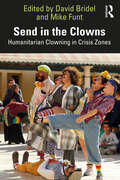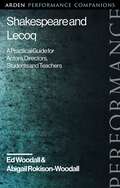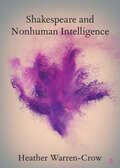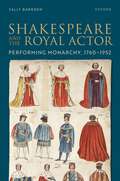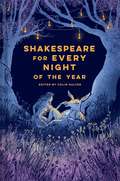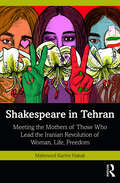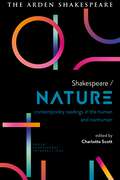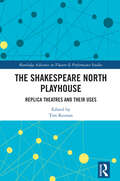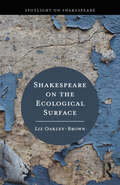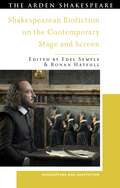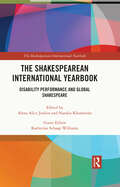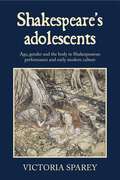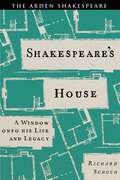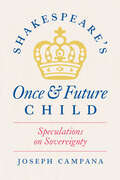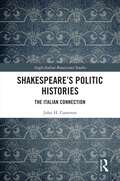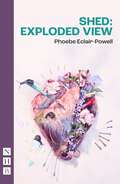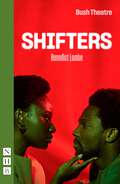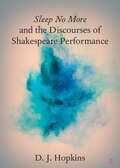- Table View
- List View
Send in the Clowns: Humanitarian Clowning in Crisis Zones
by David Bridel Mike FuntSend in the Clowns presents interviews with twenty-four pioneering humanitarian and activist clowns and thought leaders working in hospitals, refugee camps, orphanages and war zones, and at the sites of street protests and locations of social unrest across the world.This book is built around interviews with some of the world’s leading practitioners of clowning for change, justice, and health outside of the entertainment mainstream, featuring artists and organizations including Patch Adams (US), the Dream Doctors Project (Israel), Clown Me In (Lebanon), and Doutores da Alegria (Brazil). Situating the topic in relation to indigenous and ritual clowning, investigating the various functions of the clown in early societies, and centering the discourse around interviews with key practitioners, the book explores a wide range of clown applications across the globe. This includes the special significance of the clown archetype in socially, politically, and culturally challenging situations, the successes and challenges of the art activists who are at the forefront of this movement, and the modern humanitarian clown’s relationship to original forms of clowning that can be traced back through history.This is a vital resource for anyone studying, teaching, or practicing clown work in applied contexts, from health care to conflict resolution.
Shakespeare and Lecoq: A Practical Guide for Actors, Directors, Students and Teachers (Arden Performance Companions)
by Dr Abigail Rokison-Woodall Ed WoodallThis book provides actors, directors, teachers and students with a clear, practical guide to applying the work of influential theatre practitioner Jacques Lecoq to the process of rehearsing or workshopping the Shakespeare text. Written by theatre practitioner Ed Woodall, who trained with Lecoq himself, and Shakespeare academic Abigail Rokison-Woodall, this guide begins with warm-ups and ensemble-building, and moves through explorations of the story, the world of the play, the text, character emotion, thought and physicality and staging. Lecoq's method often relies on 'play', and play is often seen as trivial or inconsequential. This book argues that the more playful you are, the more playfully you investigate your speech or scene and the more physically motivated that playfulness is, the more vital and lifelike your acting of Shakespeare will be.
Shakespeare and Nonhuman Intelligence (Elements in Shakespeare Performance)
by null Heather Warren-CrowThe Infinite Monkey Theorem is an idea frequently encountered in mass market science books, discourse on Intelligent Design, and debates on the merits of writing produced by chatbots. According to the Theorem, an infinite number of typing monkeys will eventually generate the works of Shakespeare. Shakespeare and Nonhuman Intelligence is a metaphysical analysis of the Bard's function in the Theorem in various contexts over the past century. Beginning with early-twentieth century astrophysics and ending with twenty-first century AI, it traces the emergence of Shakespeare as the embattled figure of writing in the age of machine learning, bioinformatics, and other alleged crimes against the human organism. In an argument that pays close attention to computer programs that instantiate the Theorem, including one by biologist Richard Dawkins, and to references in publications on Intelligent Design, it contends that Shakespeare performs as an interface between the human and our Others: animal, god, machine.
Shakespeare and the Royal Actor: Performing Monarchy, 1760-1952
by Sally BarndenShakespeare and the Royal Actor argues that members of the royal family have identified with Shakespearean figures at various times in modern history to assert the continuity, legitimacy, and national identity of the royal line. It provides an account of the relationship between the Shakespearean afterlife and the royal family through the lens of a broadly conceived theatre history suggesting that these two hegemonic institutions had a mutually sustaining relationship from the accession of George III in 1760 to that of Elizabeth II in 1952. Identifications with Shakespearean figures have been deployed to assert the Englishness of a dynasty with strong familial links to Germany and to cultivate a sense of continuity from the more autocratic Plantagenet, Tudor, and Stuart monarchs informing Shakespeare's drama to the increasingly ceremonial monarchs of the modern period. The book is driven by new archival research in the Royal Collection and Royal Archives. It reads these archives critically, asking how different forms of royal and Shakespearean performance are remembered in the material holdings of royal institutions.
Shakespeare for Every Night of the Year
by Colin SalterImmerse yourself in the sublime words of the Bard with this sumptuous anthology of Shakespeare, with one entry for every night of the year. Chosen especially by a Shakespeare fanatic to reflect the changing seasons and daily events, the entries in this glorious book include: Romeo and Juliet on Valentine's Day. A Midsummer Night's Dream in Midsummer. The witches of Macbeth around their cauldron on Halloween. Also featured is one of Shakespeare's only two mentions of football for the anniversary of the first FA cup final. Beautifully illustrated with favourite scenes from Shakespeare's best-loved plays, this magnificent volume is a fun introduction to the well-known work and lesser known plays and poetry and is designed to be accessible to both adults and curious children. Keep this book by your bedside and luxuriate in the rich language of the greatest writer the world has ever known, for entertainment, relaxation and timeless wisdom every night of the year.
Shakespeare in Tehran: Meeting the Mothers of Those Who Lead the Iranian Revolution of Woman, Life, Freedom
by Mahmood Karimi HakakShakespeare in Tehran is a personal history of Iran through the eyes of an award-winning Iranian American artist. Drawing on parallels between life and the stage, it uses A Midsummer Night’s Dream as a roadmap to explore social, political, economic, and cultural aspects of Iran before and after the revolution of 1979. Through first-person accounts, interspersed with emotional reflections of the universal human experience, it delves into the historical and sociological context of a divided country. Storytelling, flashbacks, and flashforwards paint an intimate picture of public life in Iran in a time of uncertainty. Accessible, engaging, and nuanced, this volume will be of interest to scholars and researchers of politics, history, theater and performance studies, and West Asian studies.
Shakespeare in Tehran: Meeting the Mothers of Those Who Lead the Iranian Revolution of Woman, Life, Freedom
by Mahmood Karimi HakakShakespeare in Tehran is a personal history of Iran through the eyes of an award-winning Iranian American artist. Drawing on parallels between life and the stage, it uses A Midsummer Night’s Dream as a roadmap to explore social, political, economic, and cultural aspects of Iran before and after the revolution of 1979. Through first-person accounts, interspersed with emotional reflections of the universal human experience, it delves into the historical and sociological context of a divided country. Storytelling, flashbacks, and flashforwards paint an intimate picture of public life in Iran in a time of uncertainty. Accessible, engaging, and nuanced, this volume will be of interest to scholars and researchers of politics, history, theater and performance studies, and West Asian studies.
Shakespeare / Nature: Contemporary Readings in the Human and Non-human (Arden Shakespeare Intersections)
by Lucy Munro Professor Sonia Massai Dr Farah Karim Cooper Professor Gordon McMullanShakespeare / Nature sets new agendas for the study of nature in Shakespeare's work. Offering a rich exploration of the intersections between the human and non-human worlds, the chapters focus on the contested and persuasive language of nature, both as organic matter and cultural conditioning.Rooted in close textual analysis and historical acuity, this collection addresses Shakespeare's works through the many ways in which 'nature' performs, as a cultural category, a moral marker and a set of essential conditions through which the human may pass, as well as affect. Addressing the complex conditions of the play worlds, the chapters explore the assorted forms through which Shakespeare's nature makes sense of its narratives and supports, upholds or contests its story-telling. Over the course of the collection, the contributors examine plays including Macbeth, Julius Caesar, The Tempest, The Taming of the Shrew, Othello, Love's Labour's Lost, Hamlet, Timon of Athens and many more. They discuss them through the various lenses of philosophy, historicism, psychoanalysis, gender studies, cosmography, geography, sexuality, linguistics, environmentalism, feminism and robotics, to provide new and nuanced readings of the intersectional terms of both meaning and matter.Approaching 'nature' in all its multiplicity, this collection sets out to examine the divergent and complex ways in which the human and non-human worlds intersect and the development of a language of symbiosis that attempts to both control and create the terms of human authority. It offers an entirely new approach to the subject of nature, bringing together disparate methods that have previously been pursued independently to offer a shared investment in the intersections between the human and non-human worlds and how these discourses shape and condition the emotional, organic, cultural and psychological landscapes of Shakespeare's play worlds.
The Shakespeare North Playhouse: Replica Theatres and Their Uses (ISSN)
This collection celebrates the opening of the Shakespeare North Playhouse (SNP). After discussion of its genesis and development by four people pivotal to its progress at different stages of the project, this book explores different aspects of the SNP’s purpose and functions across three broad categories: buildings and spaces, practices and performance, and community arts and education. Various chapters offer answers to fundamental questions about replica theatres, including: Why do we build them? What do they do? How do we use them? In the course of these discussions, the purposes, potential, and programming of the SNP are discussed in relation to other Globe-type replicas in the UK and beyond. Contributors to this collection analyse key academic and practice-based concerns within their fields of expertise connected to the use (and misuse) of replica theatres to suggest the ways in which they can be used to drive research and practice in contemporary Shakespearean performance, connect with young people, and serve local communities.This book will appeal to academics, students, and practitioners interested in historical and contemporary approaches to Shakespeare in the fields covered. It should also appeal to general readers with an interest in the topics, particularly in Merseyside and the North-West region.
The Shakespeare North Playhouse: Replica Theatres and Their Uses (ISSN)
by Tim KeenanThis collection celebrates the opening of the Shakespeare North Playhouse (SNP). After discussion of its genesis and development by four people pivotal to its progress at different stages of the project, this book explores different aspects of the SNP’s purpose and functions across three broad categories: buildings and spaces, practices and performance, and community arts and education. Various chapters offer answers to fundamental questions about replica theatres, including: Why do we build them? What do they do? How do we use them? In the course of these discussions, the purposes, potential, and programming of the SNP are discussed in relation to other Globe-type replicas in the UK and beyond. Contributors to this collection analyse key academic and practice-based concerns within their fields of expertise connected to the use (and misuse) of replica theatres to suggest the ways in which they can be used to drive research and practice in contemporary Shakespearean performance, connect with young people, and serve local communities.This book will appeal to academics, students, and practitioners interested in historical and contemporary approaches to Shakespeare in the fields covered. It should also appeal to general readers with an interest in the topics, particularly in Merseyside and the North-West region.
Shakespeare on the Ecological Surface (Spotlight on Shakespeare)
by Liz Oakley-BrownShakespeare on the Ecological Surface uses the concept of the ‘surface’ to examine the relationship between contemporary performance and ecocriticism. Each section looks, in turn, at the 'surfaces' of slick, smoke, sky, steam, soil, slime, snail, silk, skin and stage to build connections between ecocriticism, activism, critical theory, Shakespeare and performance. While the word ‘surface’ was never used in Shakespeare’s works, Liz Oakley-Brown shows how thinking about Shakespearean surfaces helps readers explore the politics of Elizabethan and Jacobean culture. She also draws surprising parallels with our current political and ecological concerns. The book explores how Shakespeare uses ecological surfaces to help understand other types of surfaces in his plays and poems: characters’ public-facing selves; contact zones between characters and the natural world; surfaces upon which words are written; and physical surfaces upon which plays are staged. This book will be an illuminating read for anyone studying Shakespeare, early modern culture, ecocriticism, performance and activism.
Shakespeare on the Ecological Surface (Spotlight on Shakespeare)
by Liz Oakley-BrownShakespeare on the Ecological Surface uses the concept of the ‘surface’ to examine the relationship between contemporary performance and ecocriticism. Each section looks, in turn, at the 'surfaces' of slick, smoke, sky, steam, soil, slime, snail, silk, skin and stage to build connections between ecocriticism, activism, critical theory, Shakespeare and performance. While the word ‘surface’ was never used in Shakespeare’s works, Liz Oakley-Brown shows how thinking about Shakespearean surfaces helps readers explore the politics of Elizabethan and Jacobean culture. She also draws surprising parallels with our current political and ecological concerns. The book explores how Shakespeare uses ecological surfaces to help understand other types of surfaces in his plays and poems: characters’ public-facing selves; contact zones between characters and the natural world; surfaces upon which words are written; and physical surfaces upon which plays are staged. This book will be an illuminating read for anyone studying Shakespeare, early modern culture, ecocriticism, performance and activism.
Shakespearean Biofiction on the Contemporary Stage and Screen (Shakespeare and Adaptation)
by Professor Mark Thornton BurnettThis book is the first edited collection to explore Shakespeare's life as depicted on the modern stage and screen. Focusing on the years 1998-2023, it uniquely identifies a 25-year trend for depicting Shakespeare, his family and his social circle in theatre, film and television. Interrogating Shakespeare's afterlife across stage and screen media, the volume explores continuities and changes in the form since the release of Shakespeare in Love, which it positions as the progenitor of recent Shakespearean biofictions in Anglo-American culture. It traces these developments through the 21st century, from pivotal moments such as the Shakespeare 400 celebrations in 2016, up to the quatercentenary of the publication of the First Folio, whose portrait helped make the author a globally recognisable icon. The collection takes account of recent Anglo-American socio-political, cultural and literary concerns including feminism, digital media and the biopic and superhero genres. The wide variety of works discussed range from All is True and Hamnet to Upstart Crow, Bill and even The Lego Movie. Offering insights from actors, dramatists and literary and performance scholars, it considers why artists are drawn to Shakespeare as a character and how theatre and screen media mediate his status as literary genius.
The Shakespearean International Yearbook: Disability Performance and Global Shakespeare (The Shakespearean International Yearbook)
by Alexa Alice Joubin Natalia Khomenko Katherine Schaap WilliamsThe Shakespearean International Yearbook surveys the present state of Shakespeare studies in global contexts, addressing issues that are fundamental to our interpretive encounter with Shakespeare’s work and his time. Contributions are solicited from scholars across the field and from both hemispheres of the globe who represent diverse career stages and linguistic traditions. Both new and ongoing trends are examined in comparative contexts, and emerging voices in different cultural contexts are featured alongside established scholarship. Each volume features a collection of articles that focus on a theme curated by a specialist Guest Editor, along with coverage of the current state of the field in other aspects. An essential reference tool for scholars of early modern literature and culture, this annual publication captures, from year to year, current and developing thought in global Shakespeare scholarship and performance practice worldwide.
The Shakespearean International Yearbook: Disability Performance and Global Shakespeare (The Shakespearean International Yearbook)
by Alexa Alice Joubin Natalia Khomenko Katherine Schaap WilliamsThe Shakespearean International Yearbook surveys the present state of Shakespeare studies in global contexts, addressing issues that are fundamental to our interpretive encounter with Shakespeare’s work and his time. Contributions are solicited from scholars across the field and from both hemispheres of the globe who represent diverse career stages and linguistic traditions. Both new and ongoing trends are examined in comparative contexts, and emerging voices in different cultural contexts are featured alongside established scholarship. Each volume features a collection of articles that focus on a theme curated by a specialist Guest Editor, along with coverage of the current state of the field in other aspects. An essential reference tool for scholars of early modern literature and culture, this annual publication captures, from year to year, current and developing thought in global Shakespeare scholarship and performance practice worldwide.
Shakespeare's adolescents: Age, gender and the body in Shakespearean performance and early modern culture
by Victoria SpareyShakespeare’s adolescents examines the varied representation of adolescent characters in Shakespeare’s plays. Using early modern medical knowledge and an understanding of contemporary theatrical practices, the book unpacks complexities that surrounded the cultural and theatrical representations of ‘signs’ associated with an individual’s physical maturation. Each chapter explores the implications of different ‘signs’ of puberty, in verbal cues, facial adornments, vocal traits and body sizes, to illuminate how Shakespeare presents vibrant adolescent selves and stories.By analysing female and male puberty together in its discussion of adolescence, Shakespeare’s adolescents provides fresh insight into the age-based symmetry of early modern adolescent identities. The book uses the adolescent’s state of transformation to illuminate how the unfixed nature of adolescence was valued in early modern culture and through Shakespeare’s celebrated characters and actors.
Shakespeare's adolescents: Age, gender and the body in Shakespearean performance and early modern culture
by Victoria SpareyShakespeare’s adolescents examines the varied representation of adolescent characters in Shakespeare’s plays. Using early modern medical knowledge and an understanding of contemporary theatrical practices, the book unpacks complexities that surrounded the cultural and theatrical representations of ‘signs’ associated with an individual’s physical maturation. Each chapter explores the implications of different ‘signs’ of puberty, in verbal cues, facial adornments, vocal traits and body sizes, to illuminate how Shakespeare presents vibrant adolescent selves and stories.By analysing female and male puberty together in its discussion of adolescence, Shakespeare’s adolescents provides fresh insight into the age-based symmetry of early modern adolescent identities. The book uses the adolescent’s state of transformation to illuminate how the unfixed nature of adolescence was valued in early modern culture and through Shakespeare’s celebrated characters and actors.
Shakespeare’s House: A Window onto his Life and Legacy
by Professor Richard SchochIn the wide realm of Shakespeare worship, the house in Stratford-upon-Avon where William Shakespeare was born in 1564 – known colloquially as the 'Birthplace' – remains the chief shrine. It's not as romantic as Anne Hathaway's thatched cottage, it's not where he wrote any of his plays, and there's nothing inside the house that once belonged to Shakespeare himself. So why, for centuries, have people kept turning up on the doorstep? Richard Schoch answers that question by examining the history of the Birthplace and by exploring how its changing fortunes over four centuries perfectly mirror the changing attitudes toward Shakespeare himself.Based on original research in the archives of the Shakespeare Birthplace Trust in Stratford-upon-Avon and the Folger Shakespeare Library in Washington, DC, and featuring two black and white illustrated plate sections which draw on the wide array of material available at the Folger Shakespeare Library and the Victoria and Albert Museum, this book traces the history of Shakespeare's birthplace over four centuries. Beginning in the 1560s, when Shakespeare was born there, it ends in the 1890s, when the house was rescued from private purchase and turned into the Shakespeare monument that it remains today.
Shakespeare's Once and Future Child: Speculations on Sovereignty
by Joseph CampanaA study of Shakespeare’s child figures in relation to their own political moment, as well as our own. Politicians are fond of saying that “children are the future.” How did the child become a figure for our political hopes? Joseph Campana’s book locates the source of this idea in transformations of childhood and political sovereignty during the age of Shakespeare, changes spectacularly dramatized by the playwright himself. Shakespeare’s works feature far more child figures—and more politically entangled children—than other literary or theatrical works of the era. Campana delves into this rich corpus to show how children and childhood expose assumptions about the shape of an ideal polity, the nature of citizenship, the growing importance of population and demographics, and the question of what is or is not human. As our ability to imagine viable futures on our planet feels ever more limited, and as children take up legal proceedings to sue on behalf of the future, it behooves us to understand the way past child figures haunt our conversations about intergenerational justice. Shakespeare offers critical precedents for questions we still struggle to answer.
Shakespeare's Once and Future Child: Speculations on Sovereignty
by Joseph CampanaA study of Shakespeare’s child figures in relation to their own political moment, as well as our own. Politicians are fond of saying that “children are the future.” How did the child become a figure for our political hopes? Joseph Campana’s book locates the source of this idea in transformations of childhood and political sovereignty during the age of Shakespeare, changes spectacularly dramatized by the playwright himself. Shakespeare’s works feature far more child figures—and more politically entangled children—than other literary or theatrical works of the era. Campana delves into this rich corpus to show how children and childhood expose assumptions about the shape of an ideal polity, the nature of citizenship, the growing importance of population and demographics, and the question of what is or is not human. As our ability to imagine viable futures on our planet feels ever more limited, and as children take up legal proceedings to sue on behalf of the future, it behooves us to understand the way past child figures haunt our conversations about intergenerational justice. Shakespeare offers critical precedents for questions we still struggle to answer.
Shakespeare’s Politic Histories: The Italian Connection (Anglo-Italian Renaissance Studies)
by John H. CameronThis book argues that Shakespeare's first tetralogy is informed by the Italian ‘politic histories’ of the early modern period, those works of history, inspired by the Roman historian Tacitus, that sought to explore the machinations of power politics in governance and in the shaping of historical events; that a close reading of these Italian ‘politic histories’ will greatly aid our understanding of the ‘politic’ qualities dramatized in Shakespeare’s early English History plays; that the writings of Niccolò Machiavelli in particular will likewise aid to such understanding; that these ‘politic histories’ were available (in a variety of forms) to many English early modern writers, Shakespeare included, and are thus helpful as grounds for political and strategic analogy and for informing our reading of Shakespeare's politic histories. While a reading of the Italian ‘politic’ historians can aid in our understanding of Shakespeare’s achievement, we should regard the English History plays as ‘politic histories’ in their own right, i.e. as dramatized versions of precisely the same kinds of ‘politic’ historical writing, with its emphasis on ragion di Stato or raison d’état. This emphasis on what the Elizabethans called ‘stratagems’ suggests new ways to read the plays and to interpret the motivation and action of its characters, ways that challenge some of our more established reading of the plays’ ‘Machiavellian’ characters (particularly Richard III) and suggest far greater strategic acumen on the part of previously overlooked characters (particularly Buckingham and Stanley), providing new ways to read the Shakespeare's politic histories and to better appreciate their Italian connection.
Shakespeare’s Politic Histories: The Italian Connection (Anglo-Italian Renaissance Studies)
by John H. CameronThis book argues that Shakespeare's first tetralogy is informed by the Italian ‘politic histories’ of the early modern period, those works of history, inspired by the Roman historian Tacitus, that sought to explore the machinations of power politics in governance and in the shaping of historical events; that a close reading of these Italian ‘politic histories’ will greatly aid our understanding of the ‘politic’ qualities dramatized in Shakespeare’s early English History plays; that the writings of Niccolò Machiavelli in particular will likewise aid to such understanding; that these ‘politic histories’ were available (in a variety of forms) to many English early modern writers, Shakespeare included, and are thus helpful as grounds for political and strategic analogy and for informing our reading of Shakespeare's politic histories. While a reading of the Italian ‘politic’ historians can aid in our understanding of Shakespeare’s achievement, we should regard the English History plays as ‘politic histories’ in their own right, i.e. as dramatized versions of precisely the same kinds of ‘politic’ historical writing, with its emphasis on ragion di Stato or raison d’état. This emphasis on what the Elizabethans called ‘stratagems’ suggests new ways to read the plays and to interpret the motivation and action of its characters, ways that challenge some of our more established reading of the plays’ ‘Machiavellian’ characters (particularly Richard III) and suggest far greater strategic acumen on the part of previously overlooked characters (particularly Buckingham and Stanley), providing new ways to read the Shakespeare's politic histories and to better appreciate their Italian connection.
Shed: Exploded View (Nhb Modern Plays Ser.)
by Phoebe Eclair-PowellThe smallest tremble. A smashed glass. The ripping apart of space and time. Three couples. Thirty years. Mothers and daughters. Lovers, partners, husbands and wives. Babies, teenagers, birthdays, holidays, honeymoons, fireworks, near-misses, rain. This is a play about all of it. A devastating and delicately woven piece about violence, love and loss, Phoebe Eclair-Powell's Shed: Exploded View won the 2019 Bruntwood Prize for Playwriting. Partly inspired by Cornelia Parker's stunning artwork Cold Dark Matter: An Exploded View, it was first performed at the Royal Exchange Theatre, Manchester, in 2024, directed by Atri Banerjee. 'A gritty and intensely moving account of domestic violence… it is honest, and raw, and left me in bits' - Telegraph 'A formally ambitious exploration of love and violence… Shed: Exploded View shatters and reassembles time, leaving us to pick through the wreckage… Eclair-Powell holds individual moments up to the light, inviting us to see the darkness thrown by seemingly trivial incidents… quietly devastating' - The Stage 'Love, loss and horrific male violence… a play that is as subtle as it is unsettling' - Guardian
Shifters (Nhb Modern Plays Ser.)
by Benedict LombeDre and Des. Dream and Destiny. Young. Gifted. Black. He stayed. She left. Now, tragedy brings them crashing back into each other's lives – carrying new secrets and old scars that threaten to rewrite the past and reshape the future. Benedict Lombe's play Shifters is a fierce, funny and intoxicating romance about the enduring power – and fragility – of memory and love. It was first performed at the Bush Theatre, London, in 2024, directed by Artistic Director Lynette Linton.
Sleep No More and the Discourses of Shakespeare Performance (Elements in Shakespeare Performance)
by null D. J. HopkinsThis Element focuses on Sleep No More, the iconic immersive theatre production of Macbeth produced by the British company Punchdrunk. Sleep No More and the Discourses of Shakespeare Performance frames this Shakespeare adaptation as part of a system of ghostly citationality through which audiences understand the significance of the past in performance today. Moreover, despite its seemingly analog format, Sleep No More is discussed as a valuable site for media research. And the concept of 'uncanny spectatorship' is introduced to describe audience practice in Sleep No More and other performance contexts. Ultimately, this Element offers readers the opportunity to explore a set of concepts that are significant to the study of Shakespeare in performance and to consider the ways in which audiences interact with bodies, spaces, text, and media in Sleep No More and other immersive experiences.
